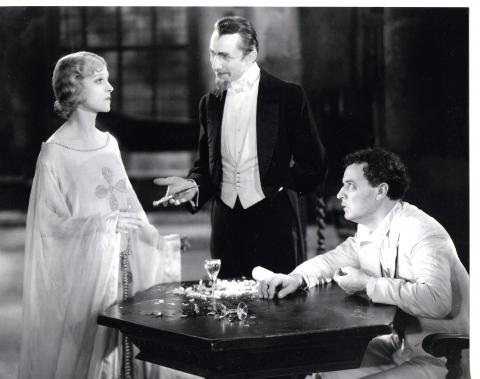WHITE ZOMBIE: A Horror Subgenre Begins

This essay on Victor Halperin's White Zombie was written by Timothy Brayton, Ph.D. candidate in the Department of Communication Arts at UW Madison. A 35mm print of White Zombie will be the fourth of four screenings on the first day of the UCLA Festival of Preservation on Saturday, February 6 at 8:15 p.m. The screening takes place in our regular Cinematheque venue, 4070 Vilas Hall.
By Timothy Brayton
There's no movie monster more reliable than the zombie, which can be had for cheap (some red food dye and a dirty, ripped shirt – boom, instant undead), and which can be pressed into duty for just about any storytelling need, be it social satire, gory action, or plain old jump scares. From the prestige of TV's The Walking Dead all the way to the self-consciously disreputable camp of Zombeavers, we live in an age of zombie ubiquity; but of course it was not ever thus. The whole teeming mass of undead cinema and television had to start somewhere, and by all accounts, that was White Zombie, a 1932 independent production made by the Halperin brothers, director Victor and producer Edward.
The very word "zombie" was still a novelty in 1932; though it can be spotted in English texts back to the beginning of the 19th Century, it owed its popularity to the 1929 pulp novel The Magic Island, which kicked off a vogue for stories of dead bodies revived through voodoo magic to serve as the slave army for this or that unscrupulous landowner in Haiti. Earlier in 1932, the stage play Zombie opened in New York, greeted by a New York Times review which spent nearly as much time explaining the concept to its reader as examining the play. Still, by the time the Halperins' film (written by Garnett Weston) rolled around in August, the reviewers clearly assumed they needed to define this bafflingly exotic phrase for their readers. A sarcastic, dismissive notice in the Times observes "the idea of the picture is that in Haiti there are individuals who dig up bodies [and] invest them with motive power", while the far more enthusiastic Variety reviewer lingers over the idea in somewhat morbid detail: "they are animate bodies without souls, generally corpses disinterred before dissolution of the physical structure..."
In short, White Zombie made quite a splash, for good or ill. While it wasn't a box office hit on the order of Dracula and Frankenstein, from the year prior, it handily made back the Halperins' $50,000 investment and then some, and its influence stretches on for decades. It provides the basic structure and many of the ingredients for very nearly every English-language zombie film into the 1960s, including those made by RKO's horror movie B-unit under Val Lewton, and by England's legendary Hammer Films. In the 1980s, aspiring rocker Robert Cummings took the film's name for his metal band White Zombie, while christening himself Rob Zombie.
Notwithstanding how important the film was in establishing one of the most prolific of horror subgenres, the contemporary viewer of White Zombie is likely to be thrown by how altogether unfamiliar it is. There are none of the cannibalistic rotting ghouls from Night of the Living Dead and its countless imitators to be found here. Here, zombies are uncanny and disturbingly otherworldly, with the true danger coming in the form of their controller, Murder Legendre, played by horror icon Béla Lugosi. Quite a potent villain he is, too. Since Variety declared him "exceptionally good" as the prime mover of all the evil in the film, virtually every commentary on White Zombie has singled out Lugosi as its strongest element. Much as in his star-making Dracula performance, the actor marries his singularly charismatic screen presence with a leering, sexually hungry menace. Whatever shortcomings White Zombie might have, Lugosi has ably kept the film charged with tension long after so many other early zombie films have entirely disappeared from view.
Murder Legendre is, to be fair, more of a background presence in White Zombie, serving as the catalyst to a relatively sedate conflict between affianced lovers Helen Short (Madge Bellamy) and Neil Parker (John Harror), and unscrupulous plantation owner Charles Beaumont (Robert Frazer), the latter of whom is willing to use Legendre's dark magic to have his way with Helen. If it sounds a little creaky and hokey, that's because it is. This is very much a film of its time, both in its relatively slow pace and melodramatic plot for a horror film, and certainly in its gender and racial politcs: no matter how potent the image of a white plantation owner with an army of unresisting brown-skinned workers performing menial agricultural tasks, White Zombie doesn't care a whit about any of those implications, honing in only on the title's promise of a pretty blonde American woman horrifyingly turned into the dead-eyed slave of Béla Lugosi.
Even so, in the moments where everything comes together just right, this is one of the clear highlights of horror cinema in the '30s. The foggy images, barely lit by cineamtographer Arthur Martinelli with murky shadows, paint the sets borrowed from Universal's much better-funded horror films with a glowering menace, and the hollowed sound, an artifact of early recording techniques, increases our sense of foreboding through minimalism. In one of the film's signature moments, we see Legendre's zombies driving a mill in the dark, making no sound except the rhythmic creak of the blades chopping sugar cane. One zombie stumbles and falls, mutely, into those same blades, with nothing interrupting the steady movement and sound of the mill. Not even the passage of eight decades have dulled the basic horror generated by this stillness, and its when it reaches these heights of unearthly atmosphere that White Zombie justifies itself as a horror classic.
